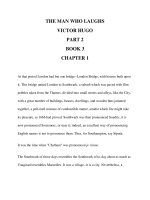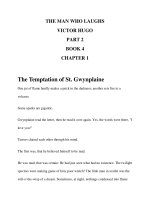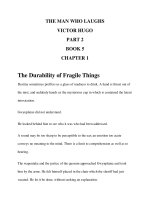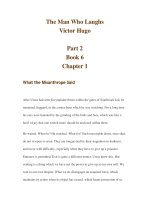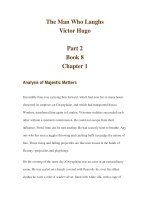Taking the TOEIC 2 (Taking the TOEIC 1 )
Bạn đang xem bản rút gọn của tài liệu. Xem và tải ngay bản đầy đủ của tài liệu tại đây (19.57 MB, 314 trang )
EDITION
Intermediate Level
Taking the
Skills and Strategies
File audio
AudioTakingtheTOEIC2
/>
Peggy Anderson
Mary Katherine Chadwick
Nancie McKinnon
Contents
Introduction
Chapter 1
6
Listening Practice
Part 1
Photographs
Theme Notes .............
................ ••••■■............
14
Mini-Tests
16
Part 2 Questions and Responses
Theme Notes •• .................
32
Mini-Tests ....................................................................................... 36
Part 3 Short Conversations
Theme Notes
.......
■•••..........
- 38
Mini-Tests ....................................................................................... 40
Part 4 Short talks
Theme Notes
...................
..............................
........ 50
Mini-Tests ......... •'............................................................................. 54
Chapter 2
Grammar Practice
1. Parts of Speech
Grammar Notes
...................
..........
72
Parts 5 & 6: Mini-Tests .................................................................. 74
2.
Tenses
-
Grammar Notes
Parts 5 & 6: Mini-Tests ..................
3.
78
80
Voice
Grammar Notes
84
Parts 5 & 6: Mini-Tests .................
86
4. Agreement
Grammar Notes
................................
90
Parts 5 & 6: Mini-Tests ................................................................. 92
5-
Infinitives and Gerunds
Grammar Notes .....................
96
Parts 5 & 6: Mini-Tests ............................................................ ■■•••• 98
6. Participles and Participle Clauses
Grammar Notes
.......
.......... ...... ................ ...... .......
102
Parts 5 & 6: Mini-Tests .............................................................. 104
Review Testi ...........................................
7.
108
Relative Clauses
..................
Grammar Notes
112
Parts 5 & 6: Mini-Tests ..................................... ........................ . 114
8. Conjunctions and Prepositions
Grammar Notes .........
118
... ................. . ...... .
Parts 5 & 6: Mini-Tests .............................................................. 120
9.
Modification
Grammar Notes
124
Parts 5 & 6: Mini-Tests .............................................................. 126
10.
Pronouns
Grammar Notes
130
Parts 5 & 6: Mini-Tests ...................
132
11. Comparisons
Grammar Notes
136
Parts 5 & 6: Mini-Tests
138
12. Conditionals
Grammar Notes ...................................................
142
Parts 5 & 6: Mini-Tests .............................................................. 144
Chapter 3
Review Test 2 .................................................................
148
Final Test ...... ••••............................
152
Reading Practice
Part 7 Reading Comprehension
Theme Notes
. . ..
158
Mini-Tests ....................................................................................
162
Chapter 4
Listening Test .............................................................................. 224
Reading Test ....................................
Transcripts & Answer Key
.....................................................................
236
Pull-out Booklet
Introduction
i. What is Taking the TOEIC® Second edition?
Taking the TOEIC® is a comprehensive guide to taking the TOEIC® Listening and Reading Test. This book can be
used as the perfect companion manual for self-learners or as a classroom text. The book is targeted for those
who have experience with the TOEIC® test but are looking to improve their basic TOEIC® skills, fix commonlymade errors, and polish their English grammar to avoid simple mistakes. This book is made up of four chapters:
three go over each section of the test in detail, and one is a practice test.
Chapter 2 Parts 1_- 4 (Listening Practice)
Each unit within the Listening Practice chapter features sample questions and answers and provides helpful
hints for developing strategies to recognize relevant information in listening passages. Part 1 introduces
common themes featured in Part 1 of theTOEIC®, such as the home, the workplace, and public places. Part 2
focuses on the most common question types and provides assistance in identifying appropriate answers for
each type. Parts 3 and 4 give sample short conversations and talks and focus on how to identify key points in
order to answer questions. Each part features mini-tests to provide practice of the strategies introduced in this
chapter.
Chapter 2 Parts 5 and 6 (Grammar Practice)
Lessons within the Grammar Practice chapter outline fundamental grammar points frequently tested on the
TOEIC®. Each lesson begins with a brief explanation of the grammar target including key points and particular
structures of interest in the TOEIC®. The lessons also provide exercises based on the format of TOEIC® grammar
questions, which allow students to practice their understanding of the grammar points. These questions match
the target grammar of that chapter or review previously learned grammar points. The questions match the real
TOEIC® in subject matter and difficulty. After six lessons, students may measure their progress with review tests.
There is also a cumulative final test at the end of the chapter.
Chapter 3 Part 7 (Reading Practice)
The Reading Practice chapter introduces sample texts to familiarize students with the kinds of materials they
will encounter on the TOEIC®—such as emails, letters, brochures, tables, chat room excerpts, text messages,
articles, and reports—together with examples of the kinds of questions students may expect to find in this part
of the test. The mini-tests provide extensive test practice using the format of questions found in Part 7 of the
TOEIC®.
Chapter 4 Practice Test
The Practice Test chapter provides students with a full-length test including 100 listening test questions and 100
reading test questions.
An answer key and MP3 files are provided for all the test questions. For the listening sections, transcriptions of
all passages and questions are available, as well as explanations for Part 5 & 6 questions. There is also an
accompanying application for this book. The app will enhance the learning experience by providing more
customized practice for students. This will allow students to truly focus on their areas of weakness.
The simplified grammar and theme-based texts of Taking the TOEIC® provide intermediate to upper-intermediate
students with access to TOEIC® practice materials appropriate for building their test-taking skills without the
frustration of encountering overly complicated vocabulary and grammar structures. Taking the TOEIC® builds an
excellent foundation for students starting preparation for the TOEIC® test.
6
ii. Why Taking the TOEIC® Second edition?
The second edition of this series is meant to reflect the recent changes made to the TOEIC® in 2016. Therefore,
students of this book will have access to the most up-to-date question formats. This series supplies plenty of
examples of the new question types to prepare students thoroughly for these changes. However, besides
focusing on the new question types, we have also selected the most common themes and questions found on
the test. Each and every question in this book was written by native English speakers who have years of
experience with theTOEIC test, bringing you a native speaker's tips and tricks to achieving a high score on this
test. Taking the TOEIC® Second Edition also introduces a brand-new feature—the Taking the TOEIC® mobile
application—to help students study better for the TOEIC®.
Key Features of the Book
Words & Expressions
/’’words 8. Expressions
/
Each part of Taking the TOEIC® includes a
n counter
■ decorations
Words & Expressions section which
■ flower arrangement
highlights vocabulary and expressions
n kitchen appliances
that are common in that part of the test.
II lamp
■ sofa/couch
■ to be stored
Tips are presented throughout the book to provide learners with
quick tips and shortcuts to solve difficult questions that frequently
confuse test takers.
Answers that express
uncertainty are very common.
Expect answers like these:
"Let me check the schedule."
"It's been here all day."
"I'm not sure."
What to Listen for/What to look for
What to look for
What to listen for
At a doc
- Who will attend this meeting?
- Why has the man come?
To requt
- What will happen at the meeting?
Voting c
- What will the man probably do?
Come b
- What is the purpose of this letter?
To enco
- Where is the conversation taking place?
Sharehc
In some sections of the book that deal with longer and more complicated passages, you will see What to listen for
or What to look for sections under sample passages. These help students familiarize themselves with possible
questions that might come up for that passage as well as what to look for in a correct answer to these questions.
7
Theme & Grammar Notes
Theme Notes
Look at the pictures below. Mark X or / in the boxes.
At the beginning of Parts 1 to 4 and
Answer Key p.19
7, Theme Notes present the reader
with sample questions and
passages that are most common in
that part of the test.
Q
i
Two women are planting some herbs.
Two women are watering some plants.
Grammar Notes
1
Present: Simple, Progressive, and Perfect
In Parts 5 & 6, Grammar Notes
present important grammar points
A. Use the present simple for routines, habits, or things that are always true. The I
the time adverbs every week, usually, regularly, always, generally, often, and freqt
and explanations with examples to
illustrate each point, as these parts
B. Use the present progressive (am/are/is + ing) for an unfinished action. It often
now, currently, presently, at the moment, and right now.
c. Use the present perfect (have/has + past participle) for a situation in which thi
past have a result in the present. The present perfect often goes with just, notyi
time, second time, this week, and so far.
focus on the test taker's knowledge
of grammar. The grammar notes you
find here are about the most
common grammar questions on the
• He takes the subway to work every day. (regular activity)
TOEIC® and are absolutely essential
• I usually go to the gym in the morning.
for students to learn.
• He is attending a meeting, (right now)
• I'm currently watching a movie at the moment. Can I call you back?
• They have scheduled the meeting for next Thursday.
Mini-Tests
Following each part, students will be given
mini-tests with lots of practice questions that
Mini-Test
Listen to the questions and choose the best answer.
can be answered using the new Taking the
TOEIC® app. Students can send their answers to
A
Questions with an Interrogative
their teacher, who can see in real-time how well
students understand the material.
0?,®
1.
(A)
(B)
(C)
o?offl
2.
(A)
(B)
(C)
3.
(A)
(B)
(C)
4.
(A)
(B)
(C)
5.
(A)
(B)
(C)
o2®
8
New Compass TOEIC® App
Throughout the book, students will see an App icon accompanying the MP3 number. Those studying with
Taking the TOEIC® will have access to a new Classroom Response Application, enhancing their learning
experience. This application will improve students'scores much more drastically than the traditional method of
only using a book.
App Features
For classroom users:
Teachers can create an interactive classroom using this book by having students answer questions in real-time.
Answers are delivered instantly to the teacher, showing them exactly where students are struggling and
excelling. This allows teachers to target their students' weaknesses.
Teachers can choose topics based on the areas that they would like to work on. The application will provide
questions based on that question type to drill students. Teachers have complete control over the type and
number of questions they use. These questions are delivered to the student's smartphone/tablet/PC, and
answers will then be reported back to the teacher. On the teacher's website, teachers will be able to view and
print out individual student records or entire class reports.
For self-study users:
Self-study users may use the app to access the MP3s. The students will also be able to use this app to gauge
how well they are doing by using the question database and practice lots of different questions, focusing on
parts they frequently get wrong. Students can figure out which parts they need to work on by checking their
scores on the student website.
How to get the app:
Google Play Store: "Classloop"
Apple App Store: "Classloop"
Website Features (www.classloop.net)
Through the website, teachers and students can view detailed reports of their results and progress as they use
Taking the TOEIC®. The site gives recommendations about areas for improvement and additional practice
questions. In addition, teachers can make customized TOEIC tests from an available pool of question.
9
HL 2016 NewTOEIC® - Changes and Updates
Educational Testing Service (ETS) created the TOEIC® test in order to gauge how well some people speak
English. As more and more people are becoming familiar with the test, there is a push to further challenge test
takers while maintaining the general difficulty of the test. In 2016, the TOEIC® underwent changes to its
questions and question types while maintaining the original set-up of theTOEIC®.The scoring system of the test
has also remained the same.
Changes to the test include:
Listening Section (Parts 1-4)
Task
Question No.
Part 1: Photographs
Listen and choose the best
description of the picture
provided.
6
Number of questions changed (10 -> 6)
Part 2: Questions and Responses
Listen and choose the best
response to the question
or statement provided.
25
Number of questions changed (30 -> 25)
Part
Question Changes
Number of questions changed (30 -> 39)
Conversations now may include three speakers.
Part 3: Short Conversations
Listen to a short
conversation and answer
comprehension questions
based on the conversation.
Two new question types introduced:
39
(13 Conversations)
1. Implication question - Questions that refer to a
direct quote from the conversation and question
their meaning (often not literal)
2. Graphic question - A simple graphic is provided
in relation to the conversation, which must be
used to answer a question.
Two new question types introduced:
Part 4: Short Talks
Listen to a short talk and
answer comprehension
questions based on the
talk.
30
(10 Talks)
1. Implication question - Questions that refer to
a direct quote from the talk and question their
meaning (often not literal)
2. Graphic question - A simple graphic is provided
in relation to the talk, which must be used to
answer a question.
Reading Section (Parts 5-7)
Part
Task
Part 5: Incomplete Sentences
Choose the best word or
phrase to fill the blank.
Part 6: Text Completion
Choose the best word,
phrase, or sentence to fill
the blank.
Part 7: Reading Comprehension
Read the provided
passage(s) and answer
questions based on the
passage(s).
Question No.
30
16
(4 passages)
54
(10 Single Passages
2 Double Passages
3 Triple Passages)
Question Changes
Number of questions changed (40 -»30)
Number of questions changed (12 -»16)
(Each passage contains 4 questions)
New question type Introduced:
Choosing the sentence that best fits the text.
Two new text types have been added:
1. Excerpts from online chats
2. Text messages
A new question type has been added:
Find the best position for the provided sentence.
Triple passage sets have been added.
Among these physical changes to the questions and passages, more diverse accents will be used in the
recordings, such as American, Canadian, British, and Australian accents. Also, more colloquial use of the
language, such as "wanna" instead of "want to" or "gonna" instead of "going to" are included in the listening
passages.
10
iv. Sample Lesson Plans
These sample lesson plans are designed to have those preparing for the TOEIC® work on both listening and
reading skills side by side over a 16-week period. These syllabi are suitable for both classroom instruction and
self-study. It can also be adjusted based on areas of strength or weakness.
Lesson Plan A
Reading Comprehension
Listening Comprehension
Week
1
Part 1 House, Workplace (p. 14, pp. 16-23)
Parts 5&6 Parts of Speech, Tenses (pp. 72-83)
2
Part 1 Businesses, Other Public Places (p. 15, pp. 24-31)
Parts 5&6 Voice, Agreement (pp. 84-95)
3
Part 2 Questions with an Interrogative (p. 32,36)
Parts 5&6 Infinitives and Gerunds (pp. 96-101)
4
Part 2 Yes/No (pp. 33-34, p.36)
Parts 5&6 Participles and Participle Clauses (pp. 102-107)
5
Part2Tag/Declarative/lndirect (pp. 34-35, p.37)
Parts 5&6 Review Test 1 (pp. 108-111)
6
Part 3 Office Talk (p. 38, pp. 40-41)
Parts 5&6 Relative Clauses (pp. 112-117)
7
Part 3 Workplace Dilemmas (p. 38, pp. 42-43)
Parts 5&6 Conjunctions and Prepositions (pp. 118-123)
Midterm Exam
8
9
Part 3 Staffing Changes (p. 39, pp. 44-45)
Parts 5&6 Modification (pp. 124-129)
10
Part 3 Daily Life (p. 39, pp. 46-47)
Parts 5&6 Pronouns (pp. 130-135)
11
Part 3 Travel (p. 39, pp. 48-49)
Parts 5&6 Conditionals, Comparisons (pp. 136-147)
12
Part 4 Office Announcements 1,2 (p. 50, pp. 54-57)
Parts 5&6 Review Test 2 (pp.148-151)
13
Part 4 Speeches/Lectures, Public Announcements
(p. 51, pp. 58-61)
Part 7 E-mails and Letters, Advertisement
(pp. 158-159,162-181)
14
Part 4 Telephone Messages, Advertisements
(p 52, pp. 62-65)
Part 7 Office Memos and Notices, Articles and Reports
(p. 160, pp. 182-201)
15
Part 4 Broadcasts, Tours and Trips (p. 53, pp. 66-69)
Part 7 Text Message and Instant Message Chains, Forms
(p. 161, pp. 202-221)
Final Exam
16
Lesson Plan B
Week
Reading Comprehension
Listening Comprehension
1
Part 1 House, Workplace (p. 14, pp. 16-23)
Parts 5&6 Parts of Speech, Tenses (pp. 72-83)
2
Part 2 Questions with an Interrogative (p. 32,36)
Part 7 E-mails and Letters (p. 158, pp.162-171)
3
Part 3 Office Talk (p. 38, pp. 40-41)
Parts 5&6 Voice, Agreement (pp. 84-95)
4
Part 4 Office Announcements 1,2 (p. 50, pp. 54-57)
Part 7 Advertisements (p. 159, pp.172-181)
5
Part 1 Businesses, Other Public Places (p. 15, pp. 24-31)
Parts 5&6 Infinitives and Gerunds (pp. 96-101)
6
Part 2 Yes/No (pp. 33-34, p.36)
Parts 5&6 Participles and Participle Clauses
(pp. 102-107)
7
Part 3 Workplace Dilemmas (p. 38, pp. 42-43)
Parts 5&6 Review Testi (pp. 108-111)
Part 7 Office Memos and Notices (p. 160, pp. 182-191)
Midterm Exam
8
9
Part 4 Speeches/Lectures, Public Announcements
(p. 51, pp. 58-61)
Parts 5&6 Relative Clauses (pp.112-117)
10
Part 2 Tag/Declarative/lndirect (pp. 34-35, p.37)
Part 7 Articles and Reports (p. 160, pp. 192-201)
11
Part 3 Staffing Changes (p. 39, pp. 44-45)
Parts 5&6 Conjunctions and Prepositions (pp. 118-123)
12
Part 4 Telephone Messages, Advertisements
(p. 52, pp. 62-65)
Parts 5&6 Modification (pp. 124-129)
13
Part 3 Travel (p. 39, pp. 48-49)
Part 7 Pronouns (pp. 130-135)
14
Part 4 Broadcasts, Tours and Trips (p. 53, pp. 66-69)
Parts 5&6 Conditionals, Comparisons (pp. 136-147)
15
Part 3 Daily Life (p. 39, pp. 46-47)
Parts 5&6 Review Test 2 (pp.148—151)
Part 7 Text Message and Instant Message Chains, Forms
(p.161,pp 202-221)
16
Final Exam
11
Chapter
Listening Practice
Part 1
Photographs
Questions and Responses
Short Conversations
Short Talks
Photographs
Them© Notes
Look at the pictures and mark / or X in the boxes.
Words & Expressions
A
Answer Key p.24
House
■ bookcase
■ bush
■ flower pot
B
patio
o potted plant
■ stool
" to be located
Q
A man is digging in the ground.
Q
A man is purchasing some flowers.
Q
A man is picking up a stick.
I
A man is walking a dog.
■ to be placed
B
to be thrown
I
■ to stack
Words &. Expressions
□
The woman is washing some dishes.
o
The man is sitting on a stool.
Q
The woman is walking through the kitchen.
Q
The man is replacing a light bulb.
Q
The woman is stacking papers on a table.
Q
The woman is opening a window.
Q
The woman is using a photocopier.
□
The woman is typing on a computer.
Q
She's opening a cabinet.
□
She's wearing safety goggles.
Q
She's operating some equipment.
I
She's cleaning some safety goggles.
Workplace
light fixture
lot
whiteboard
to adjust
rto demonstrate
to install
to lay cement
to replace
to set up
to sharpen a pencil
to shovel
to slice
to turn on
to weld
14
I
Chapter 1
i
'■'First News
c
Businesses
Words 8. Expressions
I
counter
Part 1 Photographs
display
hanger
o
Some chairs and tables have been set up outside.
□
A bag has been placed on a chair.
o
Dishes have been set on all of the tables.
hook
ladle
ledge
mannequin
tabletop
□
Blankets have been placed on some chairs.
to arrange
to be bagged
to be served
to bundle
□
Some clothing has been placed on a mannequin.
Q
Some shirts are hanging on hangers.
□
A shirt has fallen on the floor.
Ị
D
I
to peel fruit
to push in
to wipe down
A worker is folding clothes.
Other Public Places
Words & Expressions
auditorium
bench
crosswalk
□
A man is boarding a train.
Q
A train is pulling into a station.
□
A man is opening a suitcase.
platform
o
A woman is sitting on a bench on the platform.
suitcase
ground
intersection
pier
podium
to be scattered
to chain
to dock a boat
'First News
Q
Some people are climbing a tree.
o
Mats have been placed on the ground.
o
A tree has been cut down.
□
Some people are waving to each other.
to fix
to hang up
to line
to plant
to tie a shoe
Listening Practice
I
15
Mmỉ-Tests
Listen and choose the statement that best describes what you see in the picture.
A
House
Answer Key p.24
(A)
(B)
(C)
(D)
<n>
002
16
I
Chapter 1
(A)
(B)
(C)
(D)
(A)
(B)
(C)
(D)
u Part 1 Photographs
(A)
'-First News
(B)
(C)
(D)
Listening Practice
I
17
007
18
I
Chapter
(A)
(B)
(C)
(D)
(A)
(B)
(C)
(D)
(A)
(B)
(C)
(D)
'First News
I
Part 1 Photographs
(A)
(B)
(C)
(D)
o
011
(A)
(B)
(C)
(D)
(A)
(B)
(C)
(D)
Listening Practice
I
19
B
Workplace
3.
20
I
Chapter 1
Answer Key p.24
(A)
(B)
(C)
(D)
(A)
(B)
(C)
(D)
First News
I
Part 1 Photographs
0?6®
(A)
(B)
(C)
(D)
017 ra
(A)
(B)
(C)
(D)
Listening Practice
I
21
o
019
(A)
(B)
(D)
(C)
o
020
(A)
(B)
(C)
(D)
o
021
(A)
22
I
Chapter
(B)
(C)
(D)
'•'First News
I
Part 1 Photographs
0?2đ
(A)
(B)
(C)
(D)
Ê a
023 C23
(A)
(B)
(C)
(D)
0?4â
(A)
(B)
(C)
(D)
Listening Practice
I
23
c
Businesses
24 I Chapter 1
Answer Key p.24
'•'First News
(A)
'•'First News
(B)
(C)
(D)
Listening Practice
I
25
(A)
(B)
(C)
(D)
n>
032
(A)
(B)
033
(A)
26
I
Chapter 1
(B)
(C)
(D)
I
Part 1 Photographs
Listening Practice
I
27




